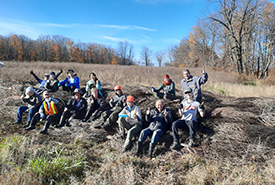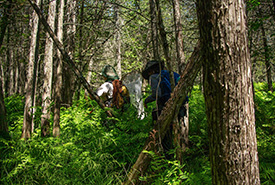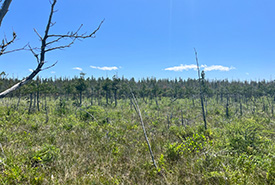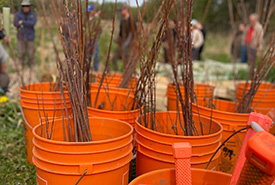NCC: Land Lines – Working in wetlands: A complex ecosystem

Wetland creation site: staff and volunteer group with newly created woody berm structure in 2022 (Photo Carolyn Davies/NCC)
The Minesing Wetlands is an incredible complex. Designated as a Ramsar Wetland of International Importance, a Provincially Significant Wetland and a Life Sciences Area of Natural and Scientific Interest, it is a critical area for conservation. This spectacular place, 15 kilometres west of Barrie, ON, is home to a diversity of wetland, aquatic and forest habitats, and it’s been very rewarding to hike deep into the swamp to monitor for species at risk — species that are at risk of disappearing locally or globally. However, hiking through the Minesing Wetlands is no easy feat, and to protect it we minimize our impacts on this sensitive ecosystem by limiting our activities to only those necessary to complete our conservation work. Working with the Nature Conservancy of Canada (NCC) as a lead conservation technician gave me the opportunity to venture into this unique area in 2023.

NCC staff bushwacking through the Minesing Wetlands (Photo by Amanda Henderson/NCC Staff)
To hike here, I wore hip waders and used sturdy hiking poles to bushwack through dense thickets and fens, and tried to avoid falling in muddy holes while pushing through the swamp. But it is absolutely worth it if you are lucky enough to come across some of the amazing species found here. Our team successfully identified three Hine’s emerald dragonflies this past season, an at-risk species who’s only known breeding location in Canada is in the Minesing Wetlands. We also monitored amphibians and observed countless bog flora, like pitcher plants, sundews and lady slippers. Along the borders of the wetlands, we conducted grassland bird surveys, observing 62 bird species, including 47 eastern meadowlarks, an at-risk species in Ontario.

The Minesing Wetlands (Photo by NCC)
Since 1962, NCC and the Nottawasaga Valley Conservation Authority (NVCA) have worked in partnership to protect over 5,500 hectares (about two-thirds) of this unique habitat. And each year, NCC and the NVCA collaborate on stewardship projects in the Minesing Wetlands, sharing resources to get more important work done.
For many years, these two organizations have been working together to restore the natural meander of Willow Creek, which enters the wetlands on the east, by installing wing deflectors. Being part of the construction of three wing deflectors over the past two years has been one of my favourite activities; it allowed me time to connect with the volunteer community while working in chest waders deep in the creek, which always leads to plenty of fun and laughs, and wet socks.
NCC and NVCA have also worked together to create new wetland communities in former agricultural fields. This restoration project will help trap sediment and excess nutrients before they can be deposited in the wetlands while reducing the impact of erosion and drought in nearby active agricultural fields. For this project, we created a woody berm structure using upcycled Christmas trees in the fall of 2022 with the help of NVCA and Conservation Volunteers from the community. We then hand-seeded the surrounding area with a native wetland seed mix to further enhance biodiversity. This involved a very wet summer day where I got covered with seeds while trying to spread them in the rain, as I trudged through a meadow with plants taller than myself.

Equipment for riparian tree planting event (Photo by Carolyn Davies/NCC Staff)
On top of all that, we are also controlling invasive species and planting trees in the Minesing Wetlands. Over the 2022 and 2023 field seasons, we planted over 2,600 native trees and shrubs, restoring a total of 5.4 hectares of deciduous swamp forest, with the help of community and student volunteers.
This is just some of the exciting work that I have had the opportunity to participate in over the past two seasons in the Minesing Wetlands, work that wouldn’t be possible without the support from Environment and Climate Change Canada’s EcoAction funding program. Working in such a significant wetland complex is always a valuable learning experience, and the Minesing Wetlands has quickly become a favourite place of mine that I feel privileged to steward.





